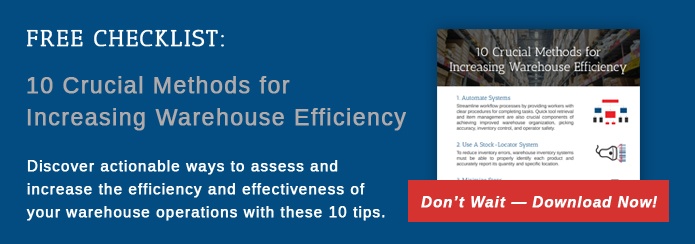 A correctly implemented Automatic Storage and Retrieval System (AS/RS) can mean lots of incremental benefits that add up to big cost savings. It's clear to see how increased inventory density and bringing goods to the workers rather than letting them inefficiently roam the warehouse can increase productivity exponentially.
A correctly implemented Automatic Storage and Retrieval System (AS/RS) can mean lots of incremental benefits that add up to big cost savings. It's clear to see how increased inventory density and bringing goods to the workers rather than letting them inefficiently roam the warehouse can increase productivity exponentially.
But uncertain – though attractive – cost savings must be weighed against a substantial upfront investment. With new equipment and management/control systems required to operate it, recouping the investment can take a while. When flexibility is of the essence, it's no wonder businesses are hesitant to make that commitment.
An employee at Abel Womack, Inc., a warehouse systems integrator based in New England, states, "An AS/RS implementation isn't suitable for every business, but the equipment can provide huge benefits for companies facing particular challenges." If your business has these sorts of problems, it's worth researching your AS/RS options.
Space Concerns
Moving to an automatic system is a sure way to use your warehouse space more efficiently, especially your vertical space, which is often sorely overlooked.
But not only vertical space can be used to your advantage. AS/RS equipment can also increase storage density horizontally by reducing the space needed for retrieval movement and reducing aisle width or eliminating aisles altogether. Smaller footprints also require less heating, lighting, and cooling.
Businesses where storage concerns are paramount – maybe expensive land prices or geographical constraints are keeping your footprint to a minimum, for instance – can find their costs reduced by deploying AS/RS equipment.
High Velocity and Volume
The higher the volume of orders leaving your warehouse, the more essential it is to bring down the cost per order. The largest operations stand to see the most benefit from implementing a fully automatic storage and retrieval system.
While looking at overall sales and order numbers is important, it's not enough to give a full picture. A large number of orders going out twice a day, for example, may see less benefit than a smaller overall number of orders frequently entering and exiting the warehouse. Both high volume and high velocity operations can see clear benefits from AS/RS implementation.
High Labor Costs
Automated systems can reduce the number of workers necessary for a given level of activity and increase the capacity of an existing workforce. Throughput is increased by bringing the goods to workers, automating picking, and reducing time spent on repetitive and mundane tasks. Recruitment and training costs can be reduced since the processes can be very systematized and validated at each step.
Difficult Working Conditions
Warehouses that have difficult conditions for manual workers, such as freezers, cold storage, or warehouses covering large areas, can be good candidates for AS/RS systems.
Freezers are known for having high worker turnover as well as reduced picking accuracy. Automated systems can raise both worker morale and productivity while reducing labor costs overall. The AS/RS can take care of the heavy lifting and freezing conditions, and the dock or control area can be kept at a comfortable working temperature.
Heavy, Fragile, or Valuable Product
Damage is a problem in a warehouse environment. Delicate inventory is more likely to be damaged by frequent operations or worker clumsiness, and this can rack up unnecessary expenses. Manually operated machinery and heavy loads such as furniture or white goods are the biggest culprits for on-site injuries and the related worker's compensation claims. Moving to automatic storage and retrieval can cut the level of worker injuries.
Automatic storage and retrieval also offers benefits for highly valuable or controlled stock by restricting worker access, limiting theft opportunities, and improving inventory tracking.
Other Considerations
- Failure
Equipment can fail. While some AS/RS systems like horizontal carousels can allow access to inventory even in the event of a failure if set up in particular ways, other AS/RS equipment will not. Using two or more pieces of equipment with inventory spread across the different machines is a smart precaution that will allow your warehouse to continue to operate even if one machine goes down. - Integration
Integration with other systems and processes is important to consider. For some applications, such as tooling or spare parts storage, it may be the case that no integration is necessary. Equipment that is holding active inventory for a manufacturing operation or a distribution center will need to fit in seamlessly with the rest of the operation. This usually means that control software that can communicate with your ERP and/or your WMS – either OEM or third-party – needs to be evaluated as part of the solution. While this adds to the upfront costs, it's offset by gains in efficiency. - Flexibility
It's much easier to change the layout of your shelving than ripping out a whole row of conveyor belts. Choosing AS/RS equipment means exchanging some flexibility for productivity – it's up to you to accurately work out the costs and benefits. Before deploying AS/RS, it's important to look at expansion plans and how significant increases or decreases in throughput can change operations. Make sure your workers and your warehouse management system are flexible enough for future decisions.




